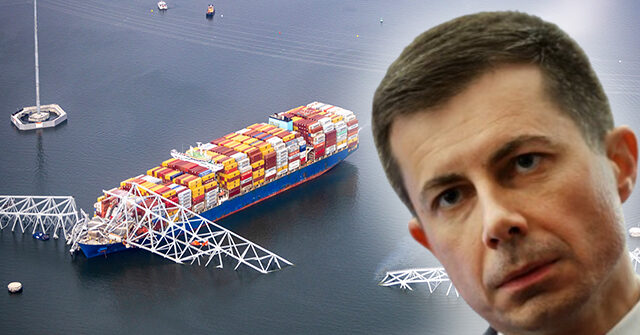Top News
Buttigieg Mess: Transportation Dept Will Not Say How Many National Defense Ships Stuck in Harbor

After an initial strong public response from President Biden vowing the federal government would do whatever it took to fix the situation, his administration is showing early signs it is bungling the response to the collapsed bridge in Baltimore.
Questions abound — such as exactly how many ships are stuck in the harbor, but the administration has been unable to provide fast or forthcoming answers.
Breitbart News has asked the Department of Transportation for answers regarding the country’s National Defense Reserve Fleet — a fleet of ships that could be used to support the military during war or emergencies, but the agency has been unable to respond.
According to another inventory list maintained by the DOT, as of January 31, 2024, there are 90 ships that are part of the National Defense Reserve Fleet, with 53 of those part of the Ready Reserve Force (RRF). RRF ships are Maritime Administration vessels assigned to the RRF to support Pentagon surge sealift requirements.
Six of those RRF ships — all roll-on/roll-off cargo ships — are assigned to Baltimore, according to the list. Those include the SS Antares, the MV Cape Washington, the MV Cape Wrath, the MV Charles L. Gilliland, the SS Denebola, and the MV Gary I. Gordon.
Breitbart News asked the DOD to confirm how many NDRF and/or RRF ships were stuck in Baltimore, but the agency has not responded.
Deputy Coast Guard Commandant Peter Gautier, during a White House press conference on Wednesday, said that there were “about a dozen ships” that remained in the port that were unable to get out, with the majority of those being foreign-flagged vessels. However, he added, “There are a number of Maritime Administration ships that are there as well.” Bloomberg reported there were at least 21 ships in the port.
According to CEO of GCaptain and maritime journalist John Konrad, four RRF ships are stuck in the port — the Antares, Cape Washington, Gary I. Gordon, and the Denebola.
He said the four ships being stuck is a “huge problem if a war starts [but] not much of a problem if the next few months are peaceful.”
“The big problem with that is two of the stuck ships are SL-7 rapid response ships,” he said, referring to the Antares and the Denebola. “SL-7s are the first to go if the balloon goes up because no other cargo ships have their speed,” he said.
According to a 2020 MARAD post on Facebook, the Antares and the Denebola are nearly the length of an aircraft carrier and are capable of sailing from the East Coast to Europe in six days, making them the fastest cargo ships in the world. “Combined, all of the [Fast Sealift Ships] can carry nearly all of the equipment needed to outfit a full Army mechanized division,” it said.
The Navy is currently involved in operations in the Mediterranean Sea amid the Israel-Hamas war, in the Red Sea to protect shipping lanes amid attacks from the Houthis in Yemen on commercial ships, and has recently been tasked to build a temporary floating pier to deliver aid to Gaza, on top of its normal operations around the world.
If there was an additional conflict in the Indo-Pacific involving the U.S., more sealift could rapidly be required.
It is also not just the military that could need the NDRF ships. In 2017, MARAD activated three NDRF ships for a FEMA mission to the Gulf of Mexico to support relief efforts after Hurricane Harvey.
Mike Stevens, CEO of the Navy League of the United States and the Navy’s 13th master chief petty officer, wrote in the New York Daily News in May 2023 that the American maritime industry’s “most important role is to provide sealift capacity and a merchant mariner force that can support our military.”
“Unlike countries that subsidize domestic maritime, our military depends not only on a private shipbuilding capacity, but a fleet of American commercial vessels and crew that can move equipment and personnel to war regions,” he wrote.
With the Port of Baltimore shut down while recovery and clean-up is underway, Department of Transportation Secretary Pete Buttigieg on Wednesday could not give a time estimate as to when the port would be reopened, whether it was in weeks, months, or even years.
“Too soon to venture an estimate. The vast majority of the port is inside of that bridge, you know, which means that most of it cannot operate, although there is a facility at what’s called Sparrow’s Point that can handle some amount of shipping, but nothing close to the totality of Baltimore,” Buttigieg said.
A reporter asked Buttigieg to “ballpark” the timing “just a little,” to which he responded, “You can imagine I’m asking our teams the same question, but I don’t want to put something out just yet.”
“Just give us something there,” the reporter pressed, before White House press secretary Karine Jean Pierre moved on to another reporter.
Former NATO Supreme Allied Commander Navy Adm. James Stavridis posted on X that he predicted it would take “a couple of months” to reopen the shipping channel.
Follow Breitbart News’s Kristina Wong on ”X”, Truth Social, or on Facebook.
Read the full article here

-
Uncategorized12 hours ago
Kəşf Etmək Binance Coin Kazino Saytları Dünyasını
-
Uncategorized13 hours ago
The Increase of Dogecoin Casino Sites: An Extensive Introduction
-
Uncategorized9 hours ago
The Surge of Crypto Slots: A New Period in Online Pc Gaming
-
Uncategorized10 hours ago
High Roller Online Casinos: Inside the Globe of Elite Betting









